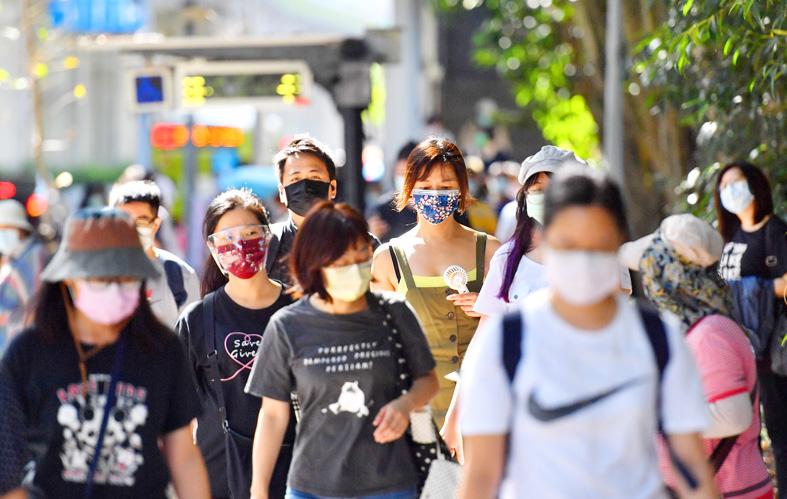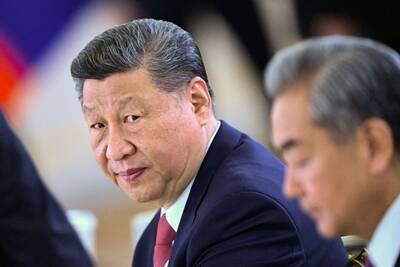The working age population in Taiwan shrank for the first time since the nation started conducting regular population censuses seven decades ago, the Directorate-General of Budget, Accounting and Statistics (DGBAS) said on Tuesday.
Citing tallies from the latest population census, which was completed at the end of November last year, the DGBAS said in a statement that the working age population, referring to people aged 15 to 64, was 16.55 million, a drop of 169,000 from the previous census in 2010.
The government conducts a census every 10 years.

Photo: CNA
The latest census was the seventh the government has completed.
Taiwan’s working age population accounted for 71.5 percent of its entire permanent resident population, which excludes migrant workers, which was 23.13 million last year, the DGBAS said.
Including migrant workers, the population was 23.83 million last year, a 0.3 percent decline from a decade ago, the statement said.
Among the permanent resident population, 22.91 million were Taiwanese and about 921,000 were foreign nationals, it said.
The number of people aged 65 or older rose by 1.23 million, or 50.1 percent, from a decade ago to 3.67 million, accounting for 15.9 percent of the total permanent resident population, the data showed.
There were 2.91 million people under the age of 15 last year, accounting for 12.6 percent of the total permanent resident population, a drop of 668,000 from 10 years earlier, the data showed.
These figures provide more evidence that Taiwan is an aging society and has a falling birthrate, the DGBAS said.
Northern Taiwan had 11.34 million permanent residents and migrant workers, or 47.6 percent of the national total, an increase of 633,000, or 5.9 percent, from a decade ago, but the growth was down from 873,000 and 8.9 percent in the decade before the previous census, it said.
Central Taiwan had 5.76 million people, or 24.2 percent, up 3.5 percent from a decade ago, the DGBAS said.
However, the population in southern Taiwan fell 1.7 percent from a decade ago, with 6.16 million, or 25.8 percent of the total, the statement said.
Eastern Taiwan reported a 4.1 percent drop in population from a decade ago to 490,000, accounting for 2.1 percent of the total, the DGBAS said.
The populations in eight cities and counties — New Taipei City, Taoyuan, Taichung, Tainan and Hsinchu, as well as Hsinchu, Yilan and Kinmen counties — rose from 2010 to last year, the data showed.
New Taipei City, Taoyuan and Taichung reported growth of 7.6, 11.4 and 11.1 percent respectively, while the population of Hsinchu County and Hsinchu City rose 21.2 and 4.8 percent respectively due to a high-tech industry cluster, the DGBAS said.

DEFENDING DEMOCRACY: Taiwan shares the same values as those that fought in WWII, and nations must unite to halt the expansion of a new authoritarian bloc, Lai said The government yesterday held a commemoration ceremony for Victory in Europe (V-E) Day, joining the rest of the world for the first time to mark the anniversary of the end of World War II in Europe. Taiwan honoring V-E Day signifies “our growing connections with the international community,” President William Lai (賴清德) said at a reception in Taipei on the 80th anniversary of V-E Day. One of the major lessons of World War II is that “authoritarianism and aggression lead only to slaughter, tragedy and greater inequality,” Lai said. Even more importantly, the war also taught people that “those who cherish peace cannot

STEADFAST FRIEND: The bills encourage increased Taiwan-US engagement and address China’s distortion of UN Resolution 2758 to isolate Taiwan internationally The Presidential Office yesterday thanked the US House of Representatives for unanimously passing two Taiwan-related bills highlighting its solid support for Taiwan’s democracy and global participation, and for deepening bilateral relations. One of the bills, the Taiwan Assurance Implementation Act, requires the US Department of State to periodically review its guidelines for engagement with Taiwan, and report to the US Congress on the guidelines and plans to lift self-imposed limitations on US-Taiwan engagement. The other bill is the Taiwan International Solidarity Act, which clarifies that UN Resolution 2758 does not address the issue of the representation of Taiwan or its people in

US Indo-Pacific Commander Admiral Samuel Paparo on Friday expressed concern over the rate at which China is diversifying its military exercises, the Financial Times (FT) reported on Saturday. “The rates of change on the depth and breadth of their exercises is the one non-linear effect that I’ve seen in the last year that wakes me up at night or keeps me up at night,” Paparo was quoted by FT as saying while attending the annual Sedona Forum at the McCain Institute in Arizona. Paparo also expressed concern over the speed with which China was expanding its military. While the US

‘FALLACY’: Xi’s assertions that Taiwan was given to the PRC after WWII confused right and wrong, and were contrary to the facts, the Ministry of Foreign Affairs said The Ministry of Foreign Affairs yesterday called Chinese President Xi Jinping’s (習近平) claim that China historically has sovereignty over Taiwan “deceptive” and “contrary to the facts.” In an article published on Wednesday in the Russian state-run Rossiyskaya Gazeta, Xi said that this year not only marks 80 years since the end of World War II and the founding of the UN, but also “Taiwan’s restoration to China.” “A series of instruments with legal effect under international law, including the Cairo Declaration and the Potsdam Declaration have affirmed China’s sovereignty over Taiwan,” Xi wrote. “The historical and legal fact” of these documents, as well